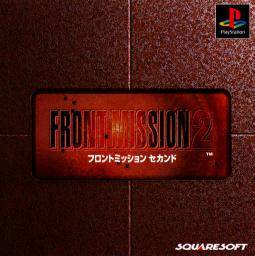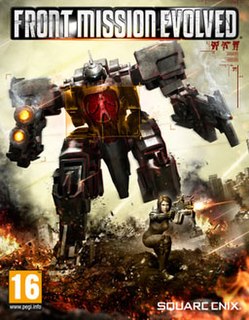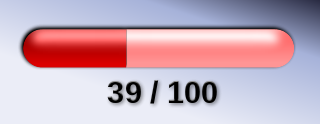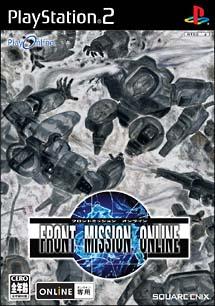| Front Mission | |
|---|---|
 New series logo with font used for Front Mission Evolved | |
| Genres | Tactical role-playing game, Third-person shooter, Side-scrolling shooter, Real-time strategy, Massively multiplayer online game |
| Developer(s) | G-Craft, Square, Square Enix, Omiya Soft, Winds, h.a.n.d., Double Helix Games |
| Publisher(s) | Square, Square Enix |
| Creator(s) | Toshiro Tsuchida |
| Platforms | SNES, PlayStation, WonderSwan Color, PlayStation 2, PC, Nintendo DS, PlayStation 3, Xbox 360 |
| Platform of origin | SNES |
| Original release | 1995 |
| First release | Front Mission February 24, 1995 |
| Latest release | Front Mission Evolved September 16, 2010 |
Front Mission(フロントミッションFuronto Misshon) is a collection of video games and related media produced by Square, now Square Enix. [1] The series was created by Toshiro Tsuchida and developed by G-Craft, a studio that was later absorbed by Square and existed within Square Enix as Product Development Division-6. Since the release of the original Front Mission in 1995, the series has gone on to encompass several media, including film, manga, novels, radio dramas, mobile phone applications, and toys. While the series is primarily rooted in the turn-based tactical role-playing genre, it has also ventured into other genres such as side-scrolling shooter, real-time strategy (RTS), massive multiplayer online (MMO), and third-person shooter through its spin-offs. The Front Mission video games have achieved moderate success, selling over 3 million units worldwide since the release of Front Mission 5: Scars of the War . [2]
Square Co., Ltd. was a Japanese video game company founded in September 1986 by Masafumi Miyamoto. It merged with Enix in 2003 to form Square Enix. The company also used SquareSoft as a brand name to refer to their games, and the term is occasionally used to refer to the company itself. In addition, "Square Soft, Inc" was the name of the company's American arm before the merger, after which it was renamed to "Square Enix, Inc".

Square Enix Holdings Co., Ltd. is a Japanese video game developer, publisher, and distribution company known for its Final Fantasy, Dragon Quest, and Kingdom Hearts role-playing video game franchises, among numerous others. Several of them have sold over 10 million copies worldwide, with the Final Fantasy franchise alone selling over 115 million. The Square Enix headquarters are in the Shinjuku Eastside Square Building in Shinjuku, Tokyo. The company employs over 4300 employees worldwide.
Toshiro Tsuchida is a Japanese game director and game producer who currently works for Japanese Social Game company GREE. He formerly worked for Square Enix Co., Ltd.. He is most notably credited for creating the Front Mission and Arc the Lad media franchises.
Contents
- Development
- Games
- Common elements
- Gameplay
- Setting
- Music
- Reception
- Legacy
- See also
- References
- See also 2
- External links
The main selling point of Front Mission is its storytelling approach. Taking place during the 21st and 22nd centuries, the series revolves around military conflicts and political tension between powerful supranational unions and their member states. [3] Although the Front Mission video games use self-contained, standalone stories, these tie into a greater overarching storyline that encompasses the entire series. In combination with the stories from its other media, the series possesses a level of storytelling depth and continuity comparable to a serial drama. [4] Another major draw of Front Mission is its use of giant mecha called "wanzers" (from the German word Wanderpanzer, or walking tanks) in battle.
A supranational union is a type of multinational political union where negotiated power is delegated to an authority by governments of member states.
The term mecha may refer to both scientific ideas and science fiction genres that center on giant robots or machines controlled by people. Mechas are typically depicted as humanoid mobile robots.

A tank is an armoured fighting vehicle designed for front-line combat, with heavy firepower, strong armour, tracks and a powerful engine providing good battlefield manoeuvrability. They are a mainstay of modern ground forces and a key part of combined arms combat. Modern tanks are versatile mobile land weapon system platforms, mounting a large-calibre cannon in a rotating gun turret, supplemented by mounted machine guns or other weapons, such as ATGMs, or rockets. They combine this with heavy vehicle armour which provides protection for the crew, the vehicle's weapons, and its propulsion systems, and operational mobility, due to its use of tracks rather than wheels, which allows the tank to move over rugged terrain and adverse conditions such as mud, and be positioned on the battlefield in advantageous locations. These features enable the tank to perform well in a variety of intense combat situations, simultaneously both offensively with fire from their powerful tank gun, and defensively due to their near invulnerability to common firearms and good resistance to heavier weapons, all while maintaining the mobility needed to exploit changing tactical situations. Fully integrating tanks into modern military forces spawned a new era of combat, armoured warfare.

















